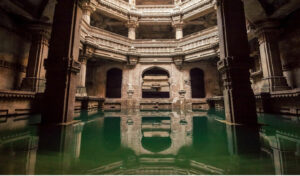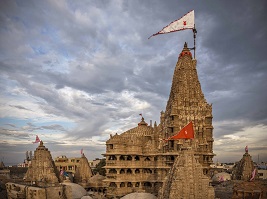Shree Dwarkadhish Temple, Dwarka – A Spiritual Gem on the Gujarat Somnath Pilgrimage Trail
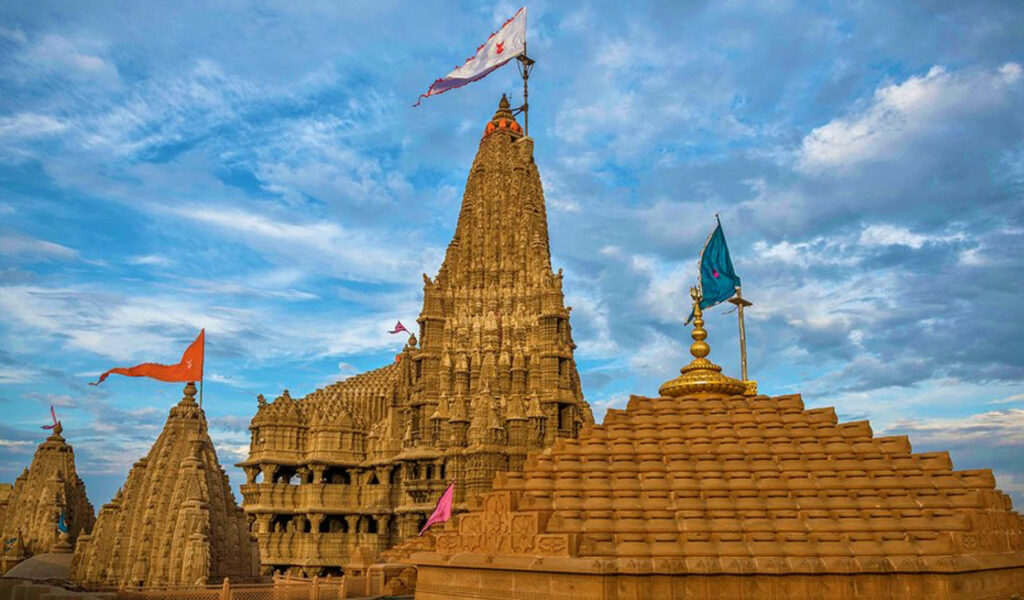
In the sacred land of Gujarat, perched on the western edge by the Arabian Sea, lies the holy town of Dwarka — famed as the ancient kingdom of Lord Krishna. At its heart stands Shree Dwarkadhish Temple, a shimmering beacon of devotion, history, and architectural grandeur. For pilgrims traversing the route from Somnath across Gujarat to Dwarka, this temple is not just a stop — it’s a spiritual high point. Join me as I walk you through its legends, what to see, how to reach, and tips to make your visit unforgettable.
Where Is Shree Dwarkadhish Temple? (with GPS Coordinates)
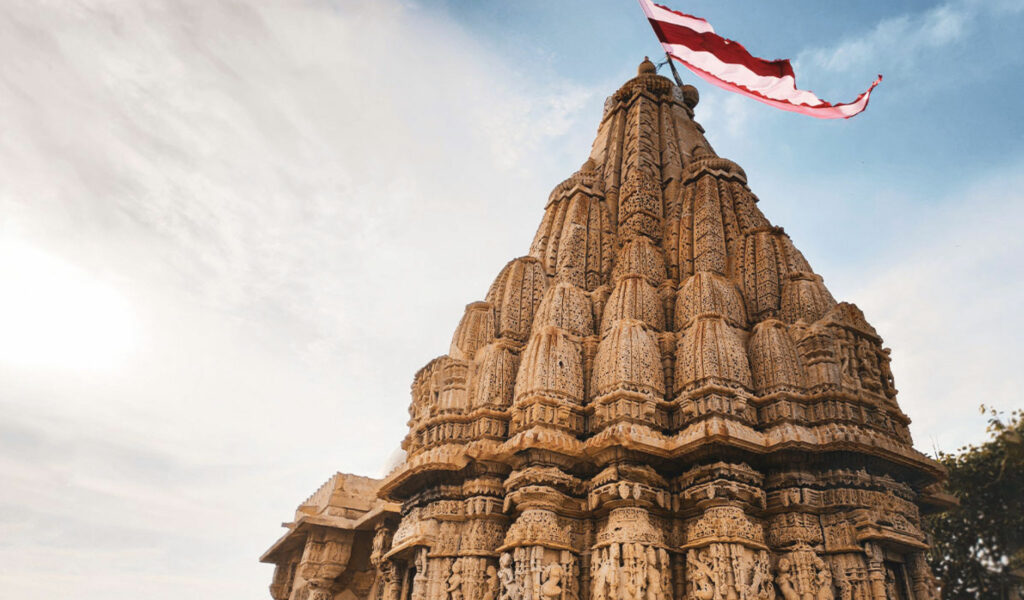
Shree Dwarkadhish Temple is located in the city of Dwarka, in Devbhoomi Dwarka district, in the western state of Gujarat, India. It is sited on the banks of the Gomti River, very near where Gomti meets the Arabian Sea. According to the Devbhoomi Dwarka district administration, the temple is also often called Jagat Mandir.
The approximate GPS coordinates for Shree Dwarkadhish Temple are:
Latitude: 22.2410° N
Longitude: 68.9688° E
You’ll find that the temple’s conical spire and giant flag can be glimpsed from quite a distance across the town, rising above the local skyline.
Mythological & Historical Significance
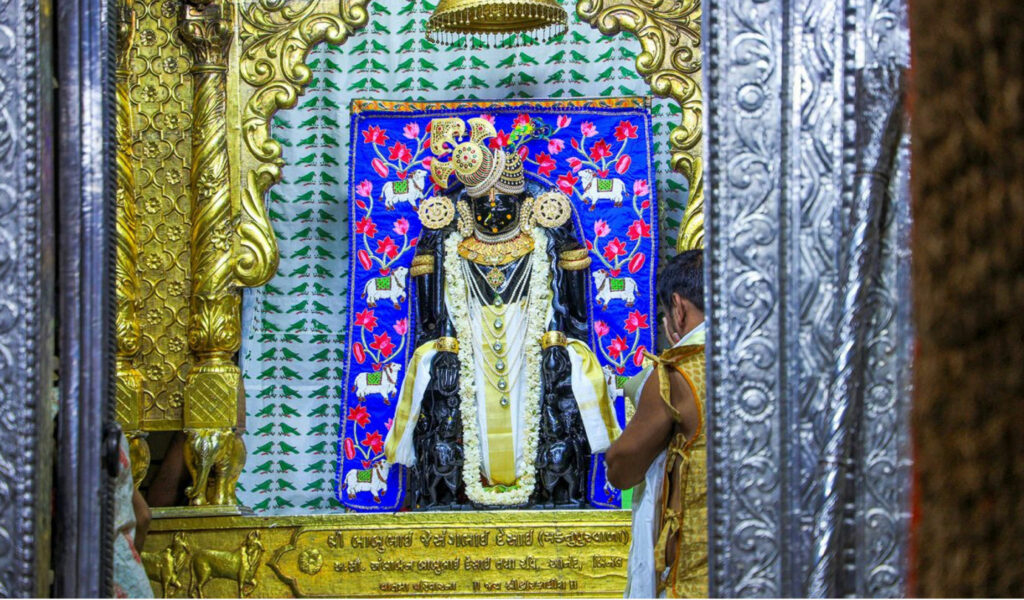
According to legend, after Lord Krishna’s life in Mathura and Dwaraka, his great-grandson Vajranabh (son of Aniruddha) is said to have built the original shrine at the site of Krishna’s ancient dwelling (Hari-griha). Over time, that original structure decayed, was destroyed, rebuilt, renovated multiple times. The site, however, is believed to preserve the sanctity of Krishna’s kingship over Dwarka.
The temple is also part of the Char Dham pilgrimage circuit (the western Dwaraka being one of the critical stops), making it a deeply revered spiritual destination in Gujarat and beyond.
Over the centuries, invaders and time took their toll. Historical records state that the medieval structure underwent major destruction and rebuilding, notably under the Gujarat Sultanate and later Hindu patronage in the 15th–16th centuries.
Architecture
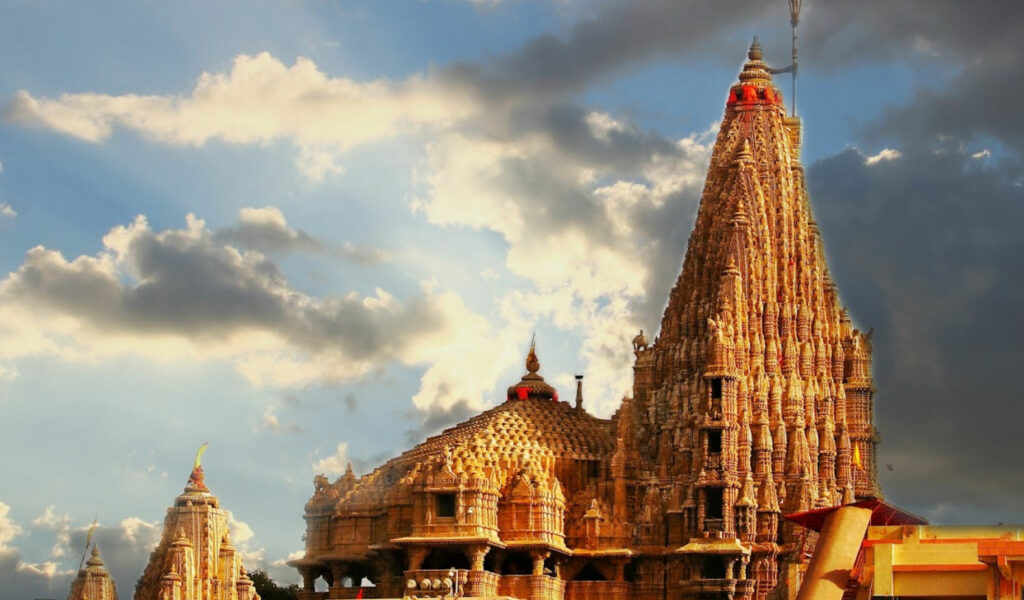
Architecturally, Shree Dwarkadhish Temple is exemplary of Chalukya / Solanki influenced styles, infused with local Saurashtrian temple art.
•The temple has five stories (five levels) with a central garbhagriha (sanctum), antarala, mandapa, and ardhamandapa.
•It is supported on 72 pillars, each carved with motifs, deities, scrollwork, and scenes of myth.
•The shikhara (spire) towers above, reaching approximately 43 m (some sources say ~50 m / 165 feet) in height.
•A notable feature is the giant flag (dhwaja) hoisted on top — made from multiple yards of cloth, visible from much of the city and even several kilometers away.
•The exterior façade is richly carved; inside, the walls are relatively plain so as not to distract from the sanctum.
Thus, the architecture serves both the grandeur of divine kingship and the solemnity of a sacred space.
What You’ll See & Do at Shree Dwarkadhish Temple
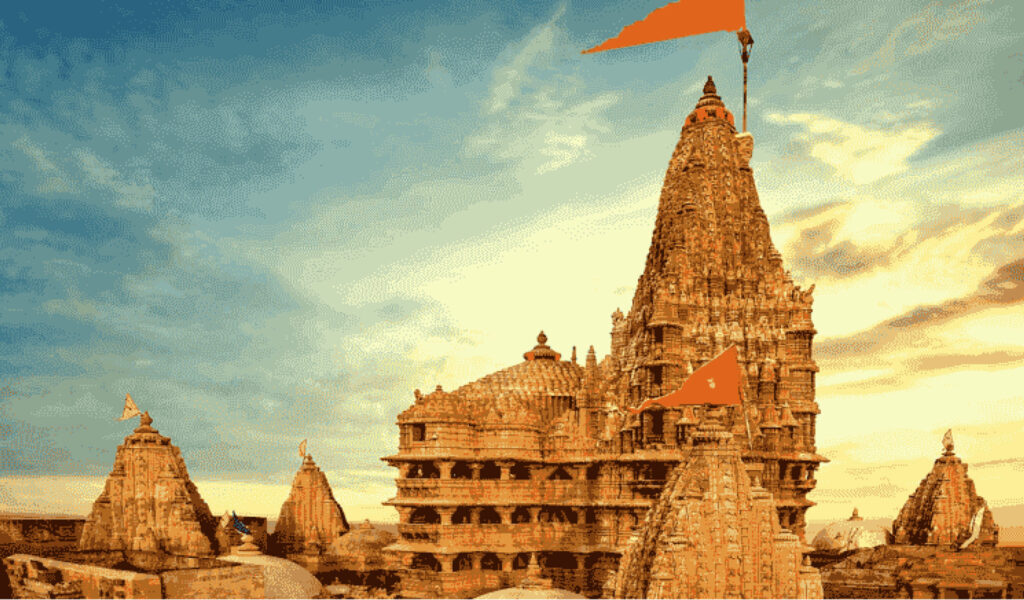
Visiting Shree Dwarkadhish Temple offers a blend of spiritual worship, architectural wonder, and local immersion. Here’s what you can expect:
•Darshan & Rituals: Multiple daily poojas follow the nityakram (daily schedule) in which Lord Krishna (in his four-armed form) is treated like a royal king (Dwarkadhish). The main aarti sessions (morning and evening) are particularly evocative.
•Interior & Sanctum: The inner sanctum houses a black stone idol of Krishna (Shaligram form), beautifully ornamented with jewels, garments, and offerings.
•Pillared halls & carvings: Walk around the mandapas and corridors to admire the 72 pillars, each telling a story in stone — gods, scenes from puranas, floral designs, and animals.
•Temple complex & smaller shrines: Around the main temple, you’ll see smaller shrines dedicated to deities like Rukmini, Aniruddha, Pradyumna, Durvasa, Devaki Mata, and Beni Madhav.
•Gomti River & Sudama Setu: After exiting, you can head toward the nearby Gomti riverbank and cross or view Sudama Setu (a pedestrian bridge) which leads you across to the creek and gives lovely views of the temple from water.
•Evening views & lighting: At night, the temple is lit up softly — it’s a different aura altogether. Also, the silhouette of the spire against twilight is a photo favorite.
•Shopping & local lanes: The narrow lanes leading to the temple are lined with stalls selling puja items, sweets (like pedas), religious souvenirs, small handicrafts, and local snacks. It’s fun to stroll and pick up mementos.
If you spend 2–3 hours, you can cover most of these — soaking in both devotion and detail.
How to Reach Shree Dwarkadhish Temple
Dwarka is well-connected by air, rail, and road. Once in Dwarka town, reaching the temple is straightforward.
By Air
•The nearest major airport is Jamnagar Airport (JGA), about 145 km away. From there, you can hire a taxi or take road transport to Dwarka.
•Another option is Porbandar Airport (PBD), which is somewhat closer (around 90–100 km).
By Train
•Dwarka Railway Station (DWK) is directly connected with major Indian cities. Many pilgrims opt for overnight trains to Dwarka.
•From cities like Ahmedabad, Rajkot, Mumbai, there are direct and connecting trains to Dwarka.
By Road
•Gujarat’s road network is good. Dwarka is reachable from cities like Ahmedabad, Rajkot, Jamnagar via state highways and NH roads.
•Once you arrive in Dwarka town, the temple is in the central area. Parking is usually 400–500 m from the main temple (you’ll walk through lanes).
•From Somnath (if you are doing a Gujarat pilgrimage connecting Somnath to Dwarka), the road distance is about 230–240 km, taking ~5–6 hours by car or bus.
Tip: If traveling from Somnath to Dwarka (or vice versa), consider breaking the journey via Junagadh or Porbandar, so you can rest and explore en route.
Nearby Places to Visit
Once you’re in Dwarka, or if you’re combining this with Somnath in Gujarat, here are must-see nearby sites:
Around Dwarka
•Bet Dwarka / Beyt Dwarka: A sacred island reachable by boat from Okha / Dwarka. It is believed to be Krishna’s original kingdom location.
•Rukmini Mata Temple: Dedicated to Rukmini (Krishna’s consort) and located close to Dwarka. It is said to have one of the oldest shrines in the region.
•Gopi Talav / Gopi Lake: A small tank named after the Gopis (Krishna’s devotees), tranquil and steeped in lore.
•Nageshwar Jyotirlinga: One of the 12 famous Shiva temples, quite near Dwarka.
•Sudama Setu & Gomti creek walks: Enjoy early morning or evening walks along the creek, taking in temple views and coastal breeze.
In the Somnath / Gujarat circuit
If your itinerary spans Somnath, consider:
•Somnath Jyotirlinga Temple (in Gir Somnath district) — one of India’s most profound Shiva shrines.
•Triveni Ghat (Somnath): Where sacred rivers meet — good for evening aarti and spiritual ambience.
•Bhalka Teerth: The site where Krishna is said to have been struck by the arrow of Jara and departed Earth.
•Ahilyabai Temple (Somnath region): Built as a substitute shrine during historic ruin of main shrine.
•Prabhas Patan Museum: Near Somnath, houses archaeological artifacts and temple ruins.
•Gir National Park (if you have extra time) — famous for Asiatic lions, somewhat farther but doable if your route allows.
When combining Gujarat Somnath Dwarka in one trip, these sites make the journey diverse — spiritual, historical, natural.
Best Time to Visit & Travel Tips
Best Time to Visit
•The ideal season is October to March — winter in Gujarat is mild, pleasant, and favorable for temple visits and walking around.
•Avoid the peak summer months (April to June), when coastal Gujarat can get extremely hot and humid, making long walks uncomfortable.
•Monsoon (July to September) sees heavy showers along the Saurashtra coast; some roads or approaches may be affected.
•For Somnath and Dwarka both, late October through February works best for combining both comfortably.
Travel Tips
1.Dress modestly — As this is a religious site, cover shoulders and legs.
2.Timing your visit — Arrive early morning (6:30 am) to catch the first darshan before crowds swell.
3.Avoid valuables — Many pilgrims advise leaving gold, wallets, or mobiles in safe places (hotel lockers).
4.Footwear / security — You’ll need to remove shoes before entering; the queue and security check may take time.
5.Darshan queues — Men and women often have separate queues; during festival times, the queues can be long.
6.Carry water & light snacks — The temple precinct has limited shops inside; better to be prepared.
7.Photography rules — Inside the sanctum, photography is rarely allowed; do check local signage or permissions.
8.Combine with Somnath — If your aim is Gujarat Somnath Dwarka pilgrimage, plan travel days accordingly so you aren’t rushed.
9.Stay in Dwarka town — Staying close to temple areas will save you walking time in early mornings or late evenings.
10.Check temple timings — The temple opens 6:30 am and closes 9:30 pm daily (with intervals) as per Gujarat expert sources.
Suggested Itinerary
Here’s a 3-day itinerary for combining Somnath → Gujarat → Dwarka (Shree Dwarkadhish Temple) in a relaxed yet fulfilling way:
Day 1: Somnath arrival & exploration
•Arrive (train/road) in Somnath by early morning.
•Visit Somnath Jyotirlinga Temple, Triveni Ghat, Bhalka Teerth, Prabhas Patan Museum, Ahilyabai Temple.
•Stay overnight in Somnath.
Day 2: Travel Somnath → along route → Dwarka zone
•Depart early from Somnath toward Junagadh or Porbandar en route.
•If time allows, visit Gir National Park, or check out local heritage sites.
•Arrive in Dwarka by evening, get settled in hotel, take a first glance of Sudama Setu / Gomti creek walk.
Day 3: Dwarka & Shree Dwarkadhish Temple
•Start at dawn, go for darshan at Shree Dwarkadhish Temple.
•Explore the temple complex, smaller shrines, corridors, carvings.
•Walk the lanes, visit Rukmini Mata Temple, Gopi Talav, cross Sudama Setu.
•If time allows, take a boat ride to Bet Dwarka (half-day).
•Depart in evening (or next morning) to next destination or return journey.
If you have more time (4–5 days), you can interpose beach days, or explore Porbandar (birthplace of Gandhi), or coastal towns between Somnath and Dwarka.
Q1. What is the significance of Shree Dwarkadhish Temple in Gujarat?
Shree Dwarkadhish Temple in Dwarka, Gujarat is one of India’s most sacred pilgrimage sites, believed to be the ancient kingdom of Lord Krishna. It is part of the Char Dham Yatra and a key stop on the Gujarat Somnath Dwarka spiritual route, representing devotion, architecture, and heritage along the Arabian Sea coast.
Q2. Who built the Dwarkadhish Temple and how old is it?
The temple is said to have been originally constructed over 2,500 years ago by Vajranabh, the great-grandson of Lord Krishna. The current structure was renovated during the 15th–16th centuries in the Chalukya architectural style. Its five-storey tower and intricately carved pillars make it a masterpiece of Gujarat’s temple art.
Q3. What are the darshan timings and aarti schedule of Dwarkadhish Temple?
The temple is open daily from 6:30 AM to 1:00 PM and 5:00 PM to 9:30 PM.
Major aartis include Mangala Aarti (early morning), Shringar Aarti (for Krishna’s adornment), and Sandhya Aarti (evening prayers). Visiting during morning aarti gives devotees a peaceful and divine experience.
Q4. How can I reach Dwarkadhish Temple from Somnath or other parts of Gujarat?
Dwarka is well connected by road, rail, and air.
•The nearest airport is Jamnagar (145 km), and Porbandar (100 km).
•From Somnath, the distance is around 230 km (5–6 hours by car).
Many pilgrims combine Gujarat Somnath Dwarka as one circuit for a complete coastal temple experience.
Q5. Is there an entry fee for Shree Dwarkadhish Temple?
No, entry for general darshan is free. Devotees can also opt for special or VIP darshan on festival days for faster entry, available through authorized counters near the temple.
Q6. What are the main attractions inside the Dwarkadhish Temple complex?
Inside the temple, visitors can see the black stone idol of Lord Krishna, intricately carved pillars, smaller shrines for Rukmini Devi, Aniruddha, and Pradyumna, and the iconic flag (Dhwaja) atop the 43-meter spire. The temple’s carvings reflect scenes from ancient epics and Krishna’s life.
Q7. What are the nearby places to visit from Dwarkadhish Temple?
You can explore Rukmini Mata Temple, Gopi Talav, Nageshwar Jyotirlinga, Sudama Setu, and take a boat to Bet Dwarka Island.
If you are on the Gujarat Somnath Dwarka route, you can continue to Somnath Temple, Triveni Ghat, and Gir National Park for a diverse experience.
Q8. When is the best time to visit Dwarkadhish Temple?
The best time to visit Dwarka is from October to March, when Gujarat’s weather is pleasant. Avoid the summer months (April–June) due to heat. The temple is especially grand during Janmashtami, Diwali, and Sharad Purnima festivals.
Q9. Are there accommodation options near Dwarkadhish Temple?
Yes. Dwarka town offers a range of stays — from budget dharamshalas and guesthouses to mid-range hotels and premium resorts. Staying near the temple (within 1 km) helps you attend early morning aarti or evening prayers comfortably.
Q10. What makes the Gujarat Somnath Dwarka route special for pilgrims?
The Gujarat Somnath Dwarka route combines two of India’s most sacred destinations — Somnath Jyotirlinga (Lord Shiva) and Dwarkadhish Temple (Lord Krishna). Traveling this circuit symbolizes the unity of Shiva and Vishnu worship, offering both spiritual merit and cultural depth along Gujarat’s stunning coastal belt.
Conclusion
A pilgrimage or trip to Shree Dwarkadhish Temple in Dwarka, Gujarat is more than a religious stop — it is a journey through myth, stone, faith, and living tradition. When you tie that in with the wider Gujarat Somnath Dwarka circuit, you get a sweeping tapestry of India’s spiritual geography: from the roaring sea at Somnath’s Jyotirlinga to the tranquil spires of Krishna’s stronghold in Dwarka. With proper planning, respect for local customs, and a willingness to slow down and absorb, your visit will be both deeply personal and expansively memorable.
Recommended Tour
Related Blogs
